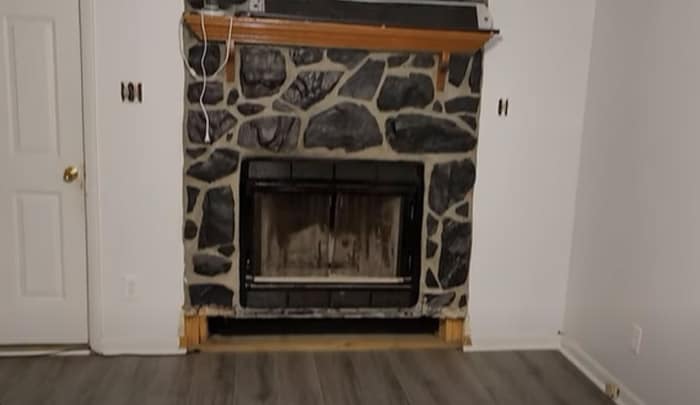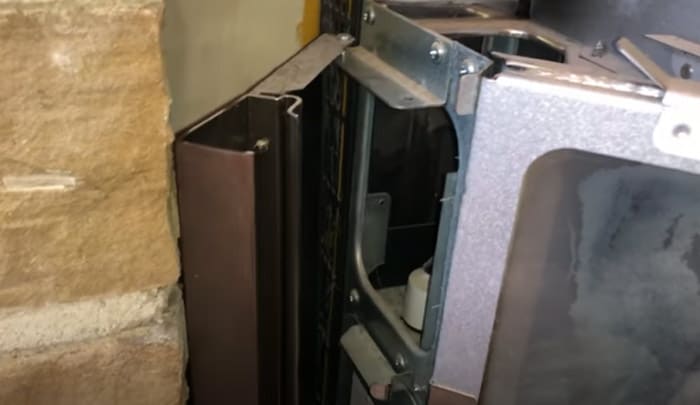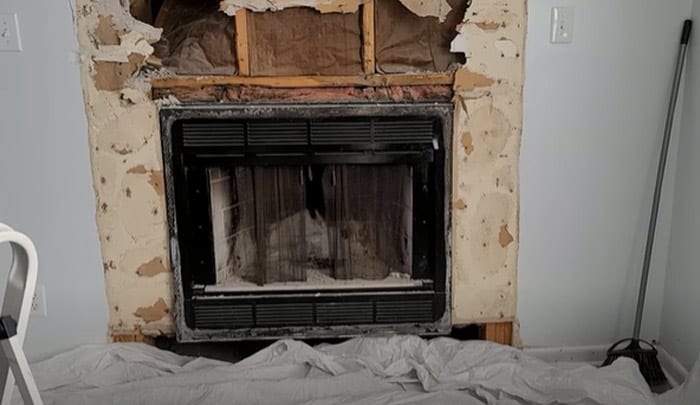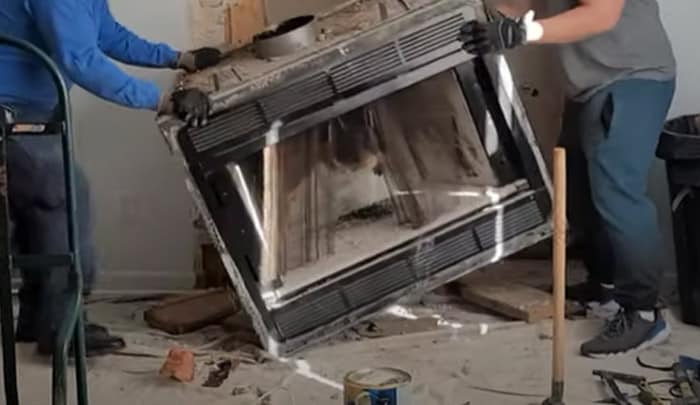Are you feeling stuck in a rut? Looking for a way to spice up your current home design without a huge expense? Or maybe you just want to start fresh by removing a no-longer used gas fireplace? Whatever your motivation, removing a gas fireplace can seem like a daunting task. But with the right tools and tips, you can safely and comfortably remove one in 6 simple steps. So, what are you waiting for? Let’s get started! And if you’re considering alternatives, you might want to explore electric fireplaces for a modern, hassle-free option!
Removing a gas fireplace requires the help of a qualified professional. To ensure safety and prevent further damage, call a heating technician certified in dealing with gas appliances to perform the removal.
“As a certified gas technician, ensuring safety around fireplaces is my utmost priority. If you’re removing a gas fireplace without professional help, remember to shut off the gas supply completely before starting any work. Additionally, it’s crucial to examine the removed gas line for possible leaks to avoid any accidents.”
Pietro Harmon, Certified Gas Technician
Preparing for the Removal of a Gas Fireplace
Before beginning the removal of a gas fireplace, it is crucial to take the necessary precautions and preparations. This is because the process can be hazardous if not done safely and accurately. If you’re considering an alternative, installing an electric fire might be a safer and easier option to explore.
First and foremost, it is essential that all occupants are away from the area before beginning to disassemble the gas fireplace. If any combustible materials have been stored near or around the gas fireplace there needs to be a discussion on whether they should be moved before starting. On one hand, removing them can reduce the risk of fire during removal; however, on the other hand, it may be seen as an additional inconvenience.
Secondly, the area should be well ventilated since disconnecting and engaging with gas components without sufficient ventilation can cause carbon monoxide buildup. Withdrawal of oxygen can also result in an explosion if any residual gas has been left in the lines when removing and unbolting the gas fireplace.
Finally, it is important to know how to properly shut off the line ensuring there will no longer be flow of fuel and ignition from accessing the home’s electrical system through loose wiring or water pipes. For these reasons preparation, is an imperative step for safely removing a gas fireplace.
After preparing for the removal of a gas fireplace, shutting off the line must be addressed in order to ensure safety for the homeowner and people living in or around the property. Following these steps are explored in great detail in our next section on “Shutting off the Line”.

Shutting off the Line
Shutting off the Line: Before starting, it is essential to shut off the gas line supplying the fireplace, by using a shutoff valve. Shutoff valves are typically located close to the fireplace and can be identified by looking for a long metal lever handle. When turning the lever, it should be done so in a clockwise direction until it clicks, indicating that the gas supply has been turned off.
The decision of whether to fully turn-off the main gas line must be made with care. Turning it off will stop all gas appliances from working in your home, which could cause issues for those who rely on gas-run kitchen appliances or boiler systems for hot water/heat. Therefore, it’s generally recommended to shut off only the line supplying the fireplace if you have enough room to work safely and avoid any further disruption.
Leading into the next section: Now that you have safely turned off the line that supplies your fireplace, it’s time to prepare the tools for removal!
Preparing the Tools
Before you can begin to safely remove a gas fireplace, it is important to have all the right tools and safety equipment. First, make sure you have reliable work gloves for grasping hot surfaces or sharp edges. Second, you will need a regular screwdriver and an adjustable wrench for loosening the mounting screws and any pipes attaching the fireplace to your wall or ceiling. You may also need a flathead screwdriver or a Phillips head screwdriver if you find any difficult-to-remove screws in the fireplace. Third, double-check to make sure your ladder is secure and stable before climbing up onto it. Finally, be prepared with plenty of rags or towels in case of any drips or spills from removing or disconnecting pipes or the fireplace unit itself.
Now that you have all the supplies necessary to safely remove your gas fireplace, you are ready to start the removal process. The next step is removing the actual fireplace logs and damper as well as anything else associated with the unit.
Removing the Fireplace Logs and Damper
Removing the Fireplace Logs and Damper is a necessary step when removing a gas fireplace. Before beginning, make sure to consult an expert for advice on how best to proceed and whether you need any special tools to complete the job. If you’re looking for a different style, you might consider installing a cast iron fireplace as an alternative.
First, turn off the gas supply to the fireplace by shutting off the valve leading in from the wall or outside cylinder. Next, remove all of the fireplace logs and their accessories—such as grates, burners, and igniters—and store them in a safe place. This will make disconnecting the damper easier.
Once all of the logs are removed, you can now begin to disconnect the damper. Before doing this step, it’s advisable to take pictures of how everything is connected so that reassembly can be done with greater precision. After taking pictures and turning off the gas supply, it’s time to disconnect the components of the damper. It should be noted that due to varying manufactures, each damper may require different levels of disassembly before being completely disconnected from the gas line.
Depending on what kind of damper assembly you have, you may be able to remove it in one piece or have to take it apart in pieces. If you have an older model, additional tools like screwdrivers or wrenches may be required to loosen connections. It’s important not to force pieces or use too much torque when loosening bolts or unscrewing pieces; doing so could cause damage or breakage within connections (which could lead to leaks down the line). Taking your time with this step is key; if needed, you can also hire a professional if desired.
Finally, after all connections are disconnected and all parts are removed its time to move onto the next step: disconnecting ventilation and appliance parts.

Disconnecting the Ventilation and Appliance
Disconnecting the Ventilation and Appliance is a crucial part of safely removing a gas fireplace. The first step in this process should be to shut off the gas supply that is connected to the appliance. This can be done using the control knob on the fireplace or by disconnecting the line at the meter. Once the gas has been shut off, it is important to disconnect the ventilation pipes, chimney caps, and/or flue seals that are attached to the fireplace unit. This must be done very carefully as these parts may contain hazardous materials such as carbon monoxide or soot and dust.
Depending on the complexity of your gas fireplace system, it may be necessary to call a professional to help with disconnecting any electrical wiring or plumbing components. If this is the case, always make sure that all power sources from both inside and outside of your home are disconnected before attempting any DIY repair. Furthermore, if you plan on disposing of any parts from your old gas fireplace, it’s important to check local laws about how to properly dispose of them in order to avoid unnecessary fines for improperly disposing of hazardous materials.
The safety and security of you and your family should always be paramount when dealing with gas appliances so always exercise caution with this step. With proper preparation and adherence to safety guidelines, disconnecting the ventilation and appliance should not present an undue risk.
Now that you have successfully disconnected the ventilation and appliance, we will look at ongoing removal in the next section.
Ongoing Removal
Once you have the access panel removed and all of the components necessary for removal accessed, you can begin removing the fireplace from its existing location. Depending on what type of fireplaces you have, some may require a bit more effort than others. It is important to take your time with this step in order to ensure the safety of yourself, those around you, and your home.
If your fireplace has additional fasteners holding it in place, make sure to remove them as well. These could include screws, nails, or expansion anchors. If you are uncertain about how to safely remove these fasteners, contact a professional for assistance.
When removing your gas fireplace, it is also important to consider whether there will be any potential hazards that may arise during the removal process. You should take precautions such as wearing gloves and eye protection while dealing with any wires or components throughout the removal process. Additionally, you should make sure that all surfaces that come into contact with the fireplace are well-ventilated so that any toxic fumes produced during its removal do not enter your living space.
In some cases, it may be necessary to disconnect any venting associated with the gas fireplace before proceeding with its removal. It is important to follow all safety protocols prescribed by the manufacturer when attempting this step. You may also want to consider hiring a professional if there is any confusion about how to safely perform this procedure.
Once disconnected from its venting source, you should proceed carefully when lifting the fireplace out of its original location. Make sure to enlist help from a few able-bodied individuals at this point if needed as it can be difficult to lift heavy objects on your own. Once outside with no weight on the interior walls of the home, securely set your now-free fireplace down in an open area where you will begin further disassembly or disposal depending on how you plan to utilize it afterwards.
This leads us into our next section which will cover how to remove parts and installation manuals from your gas fireplace before disposing or reusing it for other purposes.
Removing the Parts and Installation Manual
Removing the Parts and Installation Manual is an important step in safely removing a gas fireplace. Before beginning the removal process, you should review the manual in order to gain a better understanding of the specific components involved, as well as any associated risks that come with disassembling and handling the device. If possible, make sure you have a copy of the original installation manual handy throughout the entire removals process, as it may be necessary to consult it for reference at certain points.
It is also important to note that many modern gas fireplaces are fairly complicated pieces of machinery. Depending on each individual model, proper removal could require specialist knowledge about how certain parts interact with each other. Attempting to remove these components without an expert’s advice can potentially cause serious damage and put anyone involved in the process at risk of injury or property loss.
For this reason, those who are looking to remove their gas fireplace should take into account their personal level of expertise when it comes to taking apart large machinery. While some may be comfortable carrying out most steps of the process on their own, others may require professional consultation or help from a qualified technician before they begin.
Once you’ve assessed your capabilities and any associated risks, you can move onto the next step: securing professional help for renovations if needed.

Securing Professional Help for Renovations
Renovating a home, especially in areas that involve the installation or removal of dangerous components, is not something to be taken lightly. In order to ensure safety and ensure that the job is done correctly, homeowners should strongly consider hiring professional help for any renovations involving gas fireplaces. It’s also worth considering the long-term costs; you might wonder, are gas fires expensive to run compared to other options.
The Benefits:
Professionals have the knowledge and experience to get the job done quickly, safely and with quality assurance. Homeowners will be free from worries of complications arising from improper installation or removal techniques as professionals will be able to provide their expertise in completing the task. With this added peace of mind, it’s clear why securing professional help is the preferred option when working with gas fireplaces. Professionals can also offer quality additional features such as custom trims, mantels and cabinet packs that enhance the overall aesthetics of the fireplace.
The Drawbacks:
Although professional help comes with numerous benefits, it may not always be a feasible option due to budget restrictions. Professional home renovations can be costly and require long lead-in times. Furthermore, if a homeowner is planning to undertake DIY renovations, they should ensure that their skill set permits them to do so successfully first before taking on a complex task such as removing a gas fireplace.
In conclusion, seeking professional help for renovations involving gas fireplaces can potentially save time, energy and money; however, this solution is not necessarily suitable for all homeowners’ needs. Careful thought and preparation must be made before committing to any renovation project.

Answers to Commonly Asked Questions
What materials or tools will I need to remove a gas fireplace?
You will need a few materials and tools to safely remove a gas fireplace, including:
– Protective eyewear and gloves to protect yourself from dust and debris.
– A screwdriver or power tool to loosen bolts that connect the gas line to the fireplace.
– A wrench or adjustable wrench to disconnect gas pipe fittings.
– Gas shutoff valve key to close off the main line.
– An appropriate disposal container for ashes and other debris generated during removal of the fireplace.
– A broom and dustpan for cleaning up any debris.
These tools can help make sure you complete the job correctly and safely, while avoiding potential hazards associated with removing a gas fireplace.
What are the necessary safety precautions for removing a gas fireplace?
Safety is of the utmost importance when it comes to removing a gas fireplace. Before beginning, make sure the gas is shut off and the pilot light is extinguished. Additionally, the power must be turned off to prevent any risk of an electrical fire. Wear fire-resistant clothing and safety glasses to protect against flying debris and sparks. If working alone, consider equipping yourself with a fire extinguisher as well. It is best to have at least one other person nearby in case of emergency or if help is needed. Be sure to read the manufacturers instructions as well as any applicable safety codes before attempting to remove the gas fireplace. Once finished, carefully inspect the area to ensure all wires and pieces are accounted for and secure.
What steps are involved in removing a gas fireplace?
Removing a gas fireplace involves six main steps:
1. Lock off the gas supply. Before beginning any work, you must turn off the gas supply to your fireplace by locking off the valve on the inside of the house. This will prevent any gas leaks while working on the fireplaces.
2. Disconnect the chimney and venting system. Next, you should disconnect the liner, cover, vent and other components that are connected to the chimney and/or venting system of your fireplace. Make sure all connections have been safely disconnected before removing them from their existing positions.
3. Remove the firebox and mantle assembly. After unlocking the gas supply and disconnecting the chimney and venting system, the next step is to remove the firebox and mantle assembly from your fireplace space. Take care to securely hold onto each piece as you lift it away from its original location to prevent damaging either your wall or floor below it.
4. Dispose of appropriate materials in accordance with local regulations. Many jurisdictions have specific regulations for disposing of materials from gas fireplaces, so it is important to check with authorities in your area regarding safe disposal of materials such as ash, asbestos or other combustible substances before attempting to do so yourself.
5. Patch and repair where necessary. Once all components have been removed, you may need to patch up walls, floors or otherwise repair any surfaces to ensure they are flush with one another after removal of the fireplace assembly is complete.
6. Clean up debris and seal openings properly While you’re cleaning up debris be sure to also seal any openings created by removal of your fireplace assembly with appropriate caulk or expanding foam insulation for a secure fit and proper air circulation throughout the space afterwards
References
https://www.heatnglo.com/ideas/how-to-install-gas-fireplace-insert
https://american-chimney.com/pros-and-cons-to-a-gas-fireplace/





Removing the gas fireplace is a great choice, especially if it’s no longer utilized. However, never underestimate the importance of safely disconnecting the gas line, wearing heavy-duty gloves can protect your hands if gas leaks during the process.
You’re right, Ziff, disconnecting the gas line is indeed a critical step and protective gear is a must. When I did my own gas fireplace removal last year, I found a pair of thick leather gloves to be tremendously helpful in ensuring safety during the process.
Yes, removing a gas fireplace certainly requires precautions. I remember back in my chimney sweep days, how many homeowners underestimated the need to secure the gas line before removal; we can’t stress this point enough.
While I totally agree about the importance of securing the gas line, learned it the hard way, I should add, there is another aspect which we often overlook when removing a gas fireplace: dust. It’s insane how much dust gathers up over the years inside these fireplaces! Hence, my two cents to anyone undertaking this process would be to ensure proper ventilation and use covers for your furniture; otherwise, cleaning up after the fireplace removal might become a bigger project than removal itself.
It’s crucial to remember that the space left behind by the removed fireplace will need appropriate treatment. Depending upon your home’s layout and design, it could be converted into anything from a decorative bookshelf to an integrated part of your wall. In my extensive experience in interior design, I’ve seen some clients become frustrated when they remove a fireplace, only to be stumped about what to do with this ‘new’ space – so it’s always wise to plan ahead!
Valeria, you’re right about planning the ‘new’ space beforehand. When I removed my old gas fireplace, I ended up turning it into an antique display case with a glass cover! It became an upgrade both in terms of space utilization and aesthetics.
Absolutely agree with you Thaddeus. When I removed my gas fireplace, I turned the space into a mini herbal garden by installing some lights, it really refreshed the whole room’s vibe!
That’s a creative use of the space, Jeanine! When I removed my gas fireplace, I created a mini-library with books on various topics from engineering to nature. It added an intellectual appeal to my living room.